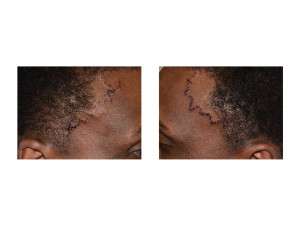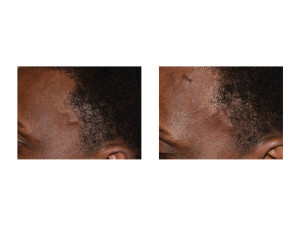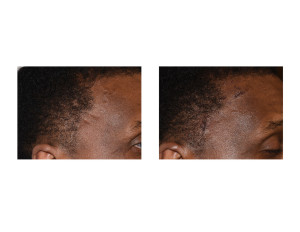Background: The superficial temporal artery is a branch of the external carotid artery. It runs up along the back line of the lower jaw and curves anteriorly where it crosses teh back part of the zygomatic arch at its junction with the temporal bone. Once it crosses the zygomatic arch, it splits into a Y into two divides in two terminal branches. The anterior branch, also called the frontal branch, ascend obliquely across the upper temporal region into the forehead. The posterior branch, also called the parietal branch, courses posteriorly above the ear.
The frontal branch of the superficial temporal artery is prone to develop extreme visibility in some people which they find bothersome. The reasons why it does so are not clear. I have only seen it in men and have never received a concern about its appearance from women. The typical symptoms are that it can not be present at all or slightly present at ‘rest’ but numerous activities make the pathway of the vessel dilate and become very prominent. Such activities includes exercise, heat, excitability, and drinking alcohol.
Treatment of the prominent anterior branch of the superficial temporal artery is by surgical ligation.While ligating the takeoff of the anterior branch would seem a logical approach, there is always the issue of backflow into it which would still leave it prominent. Thus at least a two point ligation should be done with the distal point on the forehead before it branches and goes into the frontal hairline.


The success or temporal artery ligation depends on elimination of the inflow AND subsequent collapse of the vessels. Even with two ligation, which should theoretically work, the visibility of the arteries may not always be completely eliminated. Unseen feeder vessels between the two ligation points and strength of the vessel walls (they are arteries so their walls contain muscle) may cause the vessel prominence to persist although less so than before ligation.
The other issue about the success of temporal artery ligation is whether such flow can eventually return. Loss of the ligature points (which is why I double tie) and backflow dilation of any unseen takeoff branches could all be reasons for potential recurrence.
Highlights:
1) A prominent anterior branch of the superficial temporal artery can create an undesired aesthetic line along the sides of the forehead.
2) Two-point temporal artery ligation can reduce and, in some cases, eliminate the appearance of the temporal vessels.
3) The aesthetic success of temporal artery ligation depends on whether unseen feeders flow into the visible nerve branch and how much the artery will shrink after flow into it is eliminated.
Dr. Barry Eppley
Indianapolis, Indiana



